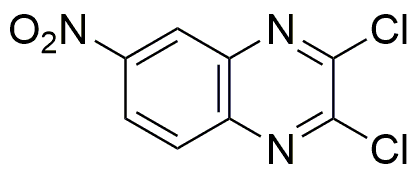2,3-Dichloro-6-nitroquinoxaline is widely utilized in research focused on:
- Neuroscience Research: This compound serves as a potent antagonist of certain glutamate receptors, making it valuable in studying excitatory neurotransmission and potential neuroprotective strategies.
- Pharmaceutical Development: It is used as a lead compound in the synthesis of new drugs targeting neurological disorders, providing insights into drug efficacy and safety profiles.
- Biochemical Assays: The chemical is employed in various assays to evaluate receptor activity and cellular responses, aiding researchers in understanding complex biochemical pathways.
- Material Science: Its unique properties allow for applications in developing specialized materials, such as sensors and electronic devices, where specific chemical interactions are crucial.
- Environmental Studies: The compound is also investigated for its effects on ecosystems, particularly in assessing the impact of pollutants on aquatic life, contributing to environmental protection efforts.
General Information
Properties
Safety and Regulations
Applications
2,3-Dichloro-6-nitroquinoxaline is widely utilized in research focused on:
- Neuroscience Research: This compound serves as a potent antagonist of certain glutamate receptors, making it valuable in studying excitatory neurotransmission and potential neuroprotective strategies.
- Pharmaceutical Development: It is used as a lead compound in the synthesis of new drugs targeting neurological disorders, providing insights into drug efficacy and safety profiles.
- Biochemical Assays: The chemical is employed in various assays to evaluate receptor activity and cellular responses, aiding researchers in understanding complex biochemical pathways.
- Material Science: Its unique properties allow for applications in developing specialized materials, such as sensors and electronic devices, where specific chemical interactions are crucial.
- Environmental Studies: The compound is also investigated for its effects on ecosystems, particularly in assessing the impact of pollutants on aquatic life, contributing to environmental protection efforts.
Documents
Safety Data Sheets (SDS)
The SDS provides comprehensive safety information on handling, storage, and disposal of the product.
Product Specification (PS)
The PS provides a comprehensive breakdown of the product’s properties, including chemical composition, physical state, purity, and storage requirements. It also details acceptable quality ranges and the product's intended applications.
Certificates of Analysis (COA)
Search for Certificates of Analysis (COA) by entering the products Lot Number. Lot and Batch Numbers can be found on a product’s label following the words ‘Lot’ or ‘Batch’.
*Catalog Number
*Lot Number
Certificates Of Origin (COO)
This COO confirms the country where the product was manufactured, and also details the materials and components used in it and whether it is derived from natural, synthetic, or other specific sources. This certificate may be required for customs, trade, and regulatory compliance.
*Catalog Number
*Lot Number
Safety Data Sheets (SDS)
The SDS provides comprehensive safety information on handling, storage, and disposal of the product.
DownloadProduct Specification (PS)
The PS provides a comprehensive breakdown of the product’s properties, including chemical composition, physical state, purity, and storage requirements. It also details acceptable quality ranges and the product's intended applications.
DownloadCertificates of Analysis (COA)
Search for Certificates of Analysis (COA) by entering the products Lot Number. Lot and Batch Numbers can be found on a product’s label following the words ‘Lot’ or ‘Batch’.
*Catalog Number
*Lot Number
Certificates Of Origin (COO)
This COO confirms the country where the product was manufactured, and also details the materials and components used in it and whether it is derived from natural, synthetic, or other specific sources. This certificate may be required for customs, trade, and regulatory compliance.

